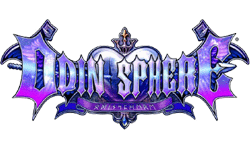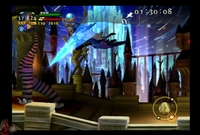|
|

|
PLATFORM
|
PS2
|
BATTLE SYSTEM
|

|
INTERACTION
|

|
ORIGINALITY
|

|
STORY
|

|
MUSIC & SOUND
|

|
VISUALS
|

|
CHALLENGE
|
Hard
|
COMPLETION TIME
|
40-60 Hours
|
|
OVERALL

|
+ Absorbing story
+ Sumptuous visuals
+ Tantalizing beat-em-up mechanics
- Way too much repetition
- Time-consuming, clunky inventory
- Sometimes-painful difficulty
|
Click here for scoring definitions
|
|
|
In 1997, a game that pushed the process of two-dimensional gaming was released for the Saturn. Princess Crown never left Japan, but it resonated strongly with those who played it, and the idea of steering clear of the third dimension was apparently a favorite of director George Kamitani. Ten years later the studio he headed, Vanillaware, released another game going boldly where many had gone before — but not lately. Odin Sphere is in some ways a startling assertion of the power 2D visuals can produce, but in others a reminder that frustration can be achieved using any method at a programmer's command.
Odin Sphere in action is rather like a beat-em-up instead of the 2D fighter that Princess Crown resembled. In order to proceed through any area of the game, all the enemies that appear must be pummeled into the ground. The process is a little different than in most beat-em-ups, though, because of the Power meter every character must mind. An all-out assault is impossible to sustain, because constant attacking drains the Power meter, and if it is allowed to completely empty four of the five characters will stand immobile until it recharges, while the fifth must reload her weapon and is thus also temporarily toothless. This mechanic means running away becomes a constant strategy, since the Power meter quickly recharges once attacking is ceased. Becoming accustomed to this methodology may take awhile, but the visceral fun of pounding multiple foes that beat-em-ups achieve has been preserved rather well.
Character growth is not accomplished via the usual methods in Odin Sphere. Enemies cough up some glowing orbs called Phozons that float around the battlefield when they die, and characters can absorb these at their leisure, with permanently increased attack power being the reward. Phozons can also be used to grow a variety of seeds that are bestowed as battle spoils, however, and the produce produced from this can be eaten to both increase a character's HP and to heal. These means of statistic enhancement can be rather time-consuming, but are also fairly entertaining.
Collecting things that can be turned into edibles is a part of the inventory, which begins as tightly constrained and stays that way throughout the game. The central problem is that the game constantly rewards players with fresh items, and almost none of them can be dismissed as useless. Characters begin with the capacity to hold only sixteen items, and while this can be increased later in their stories, item storage capacity is never proof against the enormous quantity of material offered. This results in needing to rearrange the inventory with almost every individual battlefield, which becomes aggravating at the game's beginning and stays that way. The clutter is even more pronounced once each character gains access to restaurants that prepare far more potent HP-increasing foodstuffs, since their recipes require ingredients that might otherwise be tossed aside to free precious room.
 Ingway has an odd way of making his sister feel at ease.
Ingway has an odd way of making his sister feel at ease.
|
|
Just a glance reveals the resplendent visuals of Odin Sphere, which certainly show what the PS2 could produce in this realm. Enormous sprites that take up the entire screen are routine for its bosses, the backgrounds have multiple layers and reward scrutiny, each figure onscreen moves quickly and fluidly, and the result is a feast for the eyes. The game does play host to some obnoxious slowdown at points, along with some surprisingly long load times, but these annoyances do not detract from the rich visual tapestry on display.
What really keeps the visuals in Odin Sphere from showing the PlayStation 2 at its zenith is the massive repetition to which the game resorts. There are a total of eight areas, and each character must go through seven of them. Nothing changes with each new visit, save that enemy statistics are rebalanced according to the character, and seeing the same scenery repeatedly gets boring. Bosses are subject to the same recycling of assets, and an opponent that looks amazing on the first encounter is less impressive after fighting it four times.
This repetition extends to the rest of the gameplay, since all five characters must be built up from scratch in their stories. Their play styles are sufficiently different to make beating enemies seem a little less stagnant, but needing to pump up their statistics individually is incredibly time-consuming. Vanillaware would have done well to either shorten the time spent buffing each character or include more areas and adversaries.
The areas they go through may be well-traveled real estate, but the stories of Odin Sphere are definitely not repetitious. Gwendolyn, Cornelius, Mercedes, Oswald and Velvet each have gripping narratives from a personal standpoint, and the overall plot is fascinating too. All five of them have a different perspective observing, and participating in, a complex tale of continental power struggles and the dire prediction that Armageddon is on its way in an even worse form than that made by Michael Bay. Using a fraction of the time some other RPGs have, Odin Sphere manages to craft interesting characters who undergo believable growth during the course of their stories.
 It's a good thing Beetlejuice himself never shows up - he wouldn't play fair.
It's a good thing Beetlejuice himself never shows up - he wouldn't play fair.
|
|
Atlus USA's localization is also top-notch. The many facets of the story will never be difficult to comprehend, and the translation team did a great job ensuring everything was well-done. The voice acting is particularly stellar, since solid is the lowest classification possible for just a few of the supporting roles, and all of the leads are superb.
The music composed by Basiscape is high quality also, but falls victim to the repetition of the game as a whole. The compositions tend to be very good and well-suited to each area, but they never change as characters visit locales already seen by another. This makes the quite respectable nature of the compositions become a bit mundane as they are repeated multiple times.
Odin Sphere is not as unforgiving in a certain respect as many older games, since it automatically restarts a character at the beginning of the same battlefield if death occurred. In certain cases this means the player is afforded the pleasure of trying incredibly infuriating fights ad nauseum, but at least it does not mean being booted back to the title screen. Enemies can be quite powerful in Odin Sphere, and at times taking huge chunks of damage is only partially ameliorated by the plentiful healing supplies. Pattern recognition is the way to beat most bosses, but they usually have plenty of helpers arriving to throw a monkey wrench into the proceedings.
Vanillaware succeeded in being a model for other developers with Odin Sphere's visuals and narrative, but the whole of the game doesn't quite live up to its production values. Where Princess Crown kept repetition to a minimum and stayed interesting to explore throughout, a deep ennui envelops swaths of Odin Sphere, and venturing forward becomes tiresome. The finale is worth experiencing, but the journey to reach it should have been much less tedious. Odin Sphere is a unique title with good and bad portions, one with great potential that wasn't quite achieved.
Review Archives
|









